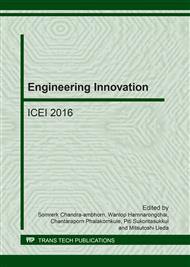p.373
p.379
p.384
p.390
p.396
p.402
p.411
p.416
p.422
Effect of Mixing Patterns for Bio-Cement
Abstract:
This research studied the effect of mixing patterns for the bio-cement in the pilot test. The bio-cementation process initiated the crystal forms of calcium carbonate (CaCO3) to bind soil particles. Formation of CaCO3 was useful for the stabilization of earth structures. Soil samples were mixed with the solution containing 250mM of CO(NH2)2, 250mM of Ca2+ (by CaCl2), and urease concentrations of 20 % (v/v). For clay, there were three types of mixing blades; the rectangle, the spiral and the comb blades. The research found that firstly the sample mixed by the comb blade showed the highest value of shear wave velocity of 210.5 m/s. Secondly, the sample mixed by the rectangle blade showed the shear wave velocity of 167.3 m/s. Lastly, the sample mixed by the spiral blade showed the lowest value of the shear wave velocity of 150.6 m/s. For sand, there were 4 injection methods; (a) pour all the solution at one time (b) continuous drop (c) period drop and (d) period injection. The research found that the method (a) was a disadvantage method since it improved the ground only at the bottom area. In the same way, the method (b) was also a disadvantaged method because it improved the ground only at the top area. The most recommended methods were the methods (c) and (d) which improved the ground strength continuously along the depth.
Info:
Periodical:
Pages:
396-401
Citation:
Online since:
January 2017
Authors:
Keywords:
Price:
Сopyright:
© 2017 Trans Tech Publications Ltd. All Rights Reserved
Share:
Citation:


